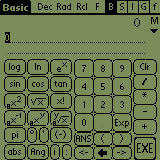
Other features:

 enter '3+3' EXE ->
enter '3+3' EXE ->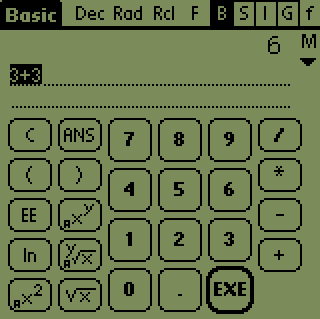

Now to some of the things you can see on screen. The 'Rcl' is for fast access to variables, 'F' is for fast access to functions (be sure and create your own - see below) and 'H' stands for history.
There are 2 different layouts of the Basic screen. You can switch it
in Preferences. The second form of the Basic layout is more crowded,
but some people like it.

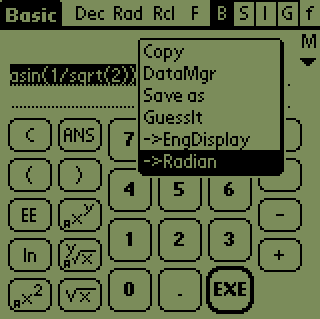
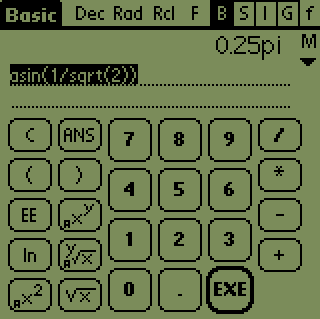
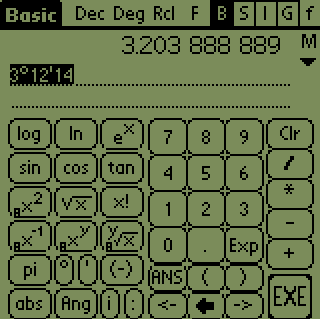
There are some comfort functions for working with degrees and radians. They
are located in a small menu, that appears when you click the 'M' on the
right side of the results field. It features - among other things - the '->Degree'
and '->Radian' function, that changes the output to a more readable form. Of
course you can try the 'Copy' option and Paste it into the input field - and
it works. The degrees are written somewhat easier this way:
 . But
only, of course, if you learn how to write the special degree character, or
select the Basic=>Scien check box in Preferences to get a Basic screen that
has the degree and minute characters (right hand figure above). The
Degree/Radian/Grad can be switched in Preferences or as a convenience you can
change the mode by tapping the Deg/Rad/Grd indicator at the top of the
display. Selection of Dec/Hex/Oct/Bin can be made in the same way.
This saves time in that you do not need to go to Preferences Screen to change
trig modes or number radix.
. But
only, of course, if you learn how to write the special degree character, or
select the Basic=>Scien check box in Preferences to get a Basic screen that
has the degree and minute characters (right hand figure above). The
Degree/Radian/Grad can be switched in Preferences or as a convenience you can
change the mode by tapping the Deg/Rad/Grd indicator at the top of the
display. Selection of Dec/Hex/Oct/Bin can be made in the same way.
This saves time in that you do not need to go to Preferences Screen to change
trig modes or number radix.
NOTE: You must be in Deg mode vs. Rad or Grd to enter numbers in degrees!
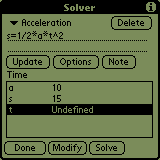
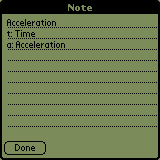

You can use the solver to store and document your formulas. If there is no '='
found, Solver just computes the result.

f()="function expression"EasyCalc offers the ability to define functions so that you can use them later.
f()="x^2-4"
f(5)
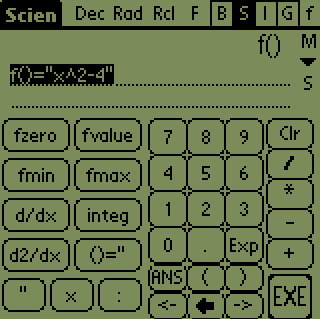
 You get the answer 21.
You get the answer 21.
fzero(min:max:func[:error[:params]])This function finds the root of a function using the method 'division of interval'.
Example:
fzero(-1:4:"x^3-x^2-5")
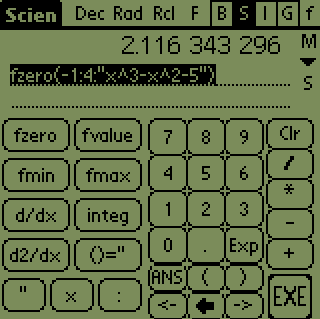
f()="x^2-4"
fzero(-1:4:f())
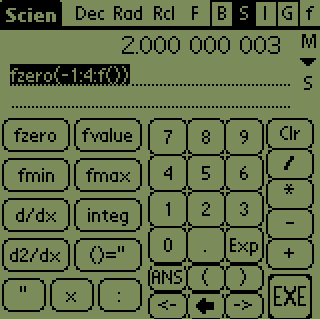
It is possible to add additional parameters to the function being solved. All parameters that are passed to fzero() after the error parameter are passed to the inner function.
fzero(-100:100:"x(2)*x^2+x(3)*x+x(4)":1E-8:2:3:-2)This function would solve a quadratic function a*x^2+b*x+c, where a is 2, b is 3 and c is -2.
fvalue(min:max:value:func[:error[:params]])The function fvalue tries to find a point where f(x)=value.
fintersect(min:max:f1:f2[:error[:params]])
The function fintersect tries to find a point where f1(x)=f2(x).
All restrictions of function fvalue apply to these 2 functions.
Example:
fromberg(-1:4:"x^3+x^2-5")

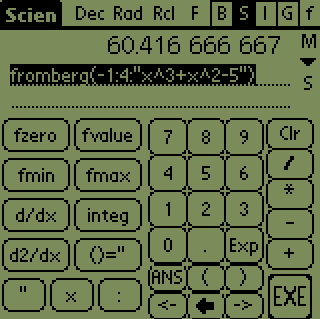
fd_dx(x:func[:error[:params]])EasyCalc supports finding the first and second derivatives of a function. The function fd_dx finds the first derivative at the point x and the function fd2_dx finds the second derivative at the point x.
fd2_dx(x:func[:error[:params]])
Example: Let's have the function  where the
derivative is
where the
derivative is  . Let x=2, then
. Let x=2, then
 .
.
fd_dx(2:"x^2-4")

[[:a11:a12:...]:[a21:a22]:...[...: anm]]This form creates a user defined matrix.


Example: b=[[1.1:1.2]:[1.3:1.4]:[1.5:1.6]]

b=[[1:i]:[i:3]]
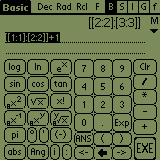
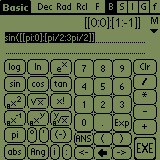
(matrix_a)+(matrix_b)Easycalc supports all standard matrix operations like adding, subtracting and multiplying matrices.
(matrix_a)-(matrix_b)
(matrix_a)*(matrix_b)
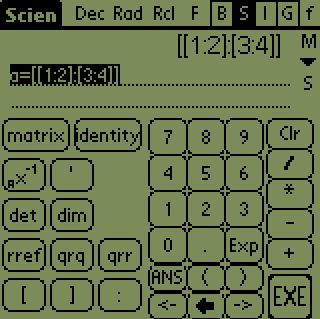

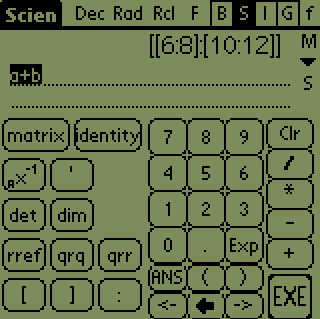

identity(n)This function generates an identity matix with dimension n.



(matrix_a)^(-1)Example:
(matrix_a)'
a=[[1:2]:[3:4]] a^(-1)
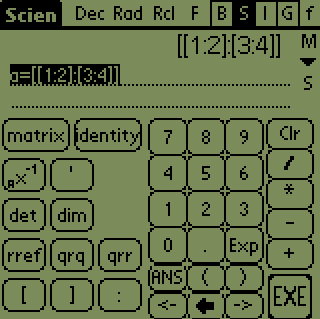

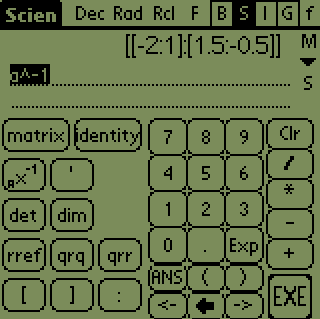


Example:
a=[[1:2:3]:[4:5:6]]
b=a'

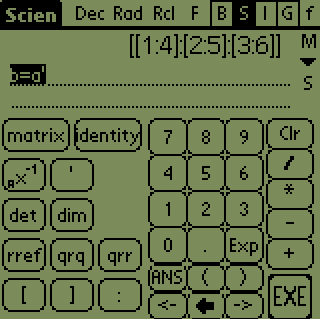


rref(a)This functions reduces dependent rows, it is usually used to find a solution to system of equations.
1x + 2y = 3
4x + 5y = 6Put these two linear equations in matrix form with right hand side appended as right column.
a=[[1:2:3]:[4:5:6]]
rref(a)A row echelon form is returned as evidenced by the leading 1's propagating downward and to the right.
The results for x and y are returned as the right column of rref(a). And the solution can be
verified, see below.1*(-1) + 2*(2) = 3
4*(-1) + 5*(2) = 6



qrq(a) and qrr(a) return Q and R respectively as Factorization of matrix aqrs(Ab) solves linear equation Ax = b like rref only using QR decomposition and backsubstitution. This approach may
solve matrix that are not solvable with rref.
The qrq and qrs functions combined will compute the orthogonal Q, and upper
triangular R matrix, respectively, of an m x n matrix using Householder
method. For m = n, Q and R are the same size as the original
matrix. For m(rows) x n(cols) the Q matrix is size m x m and R is
size m x n. The result of qrq(a) * qrr(a) should return the original
matrix ' a '. QR generally decomposes a full rank matrix to a simpler
form.
Another interesting property is that Q*Q' =
Q'*Q = I the
identity matrix.
Examples:
First enter a matrix --- ' mat3_4=[[1:2:3:4]:[2:3:4:5]:[3:4:5:6]] '
then try --- ' qrq(mat3_4) '

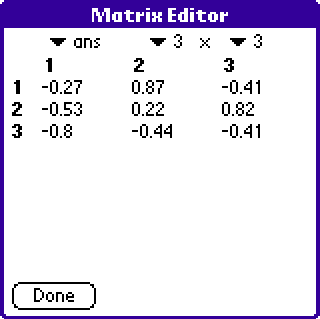 Q
Q
and ' qrr(mat3_4) '
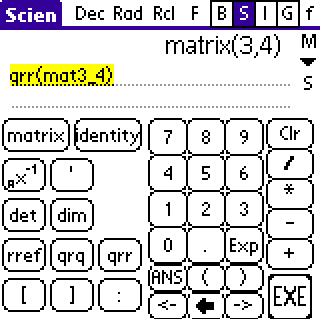
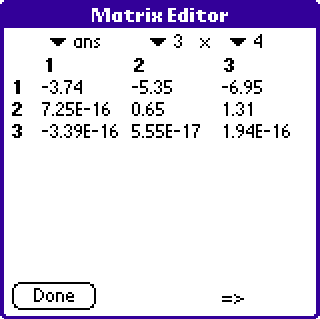 R - upper triangular - but zero is near
1e-16.
R - upper triangular - but zero is near
1e-16.
finally try ' qrq(mat3_4) * qrr(mat3_4) '
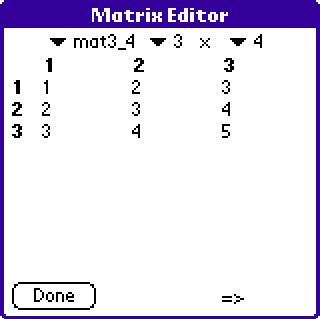 The original matrix - use => to see remaining columns.
The original matrix - use => to see remaining columns.
Given Q and R, problems such as Ax = b can readily be solved by
replacing A with QR. This is readily accomplished with
function qrs.
In this example the same matrix a appended with b as used
above for rref was entered into mat2_2e. The original a
is returned along with
the solution x which is -1, 2. Note: The Matrix can be
complex but also note that for qrs the matrix must currently
be square.
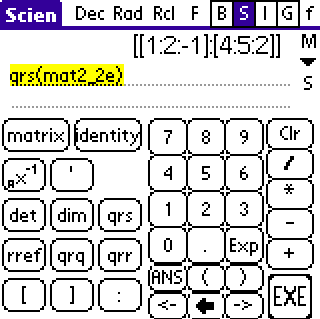
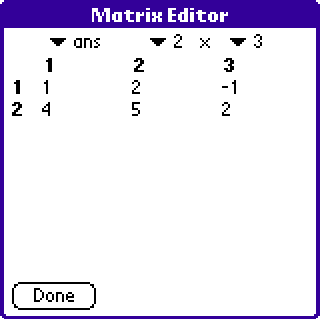
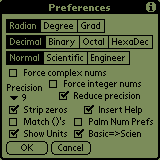
Tap the
' I ' on the top and change to the 'Integer' screen: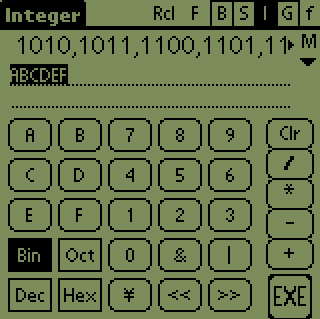 In
this example enter 'ABCDEF' with HEX selected then select BIN.
In
this example enter 'ABCDEF' with HEX selected then select BIN.
EasyCalc works with 32-bit unsigned integers and supports simple binary
operations - AND(&), OR(|), ShiftLeft(<), ShiftRitght(>) and
XOR(the 'yen'). It
also supports base conversions. If you do not check the
Integer input in preferences, all numbers will be treated as 'float' and for
float numbers are not defined the and,or,shl and shr operations. Write in some number and press the 'Exe' key and the number will
appear in the Result area. Now tap on the base you want to convert to and the
number will be converted. DO NOT FORGET TO CHECK THE MODE BACK TO DECIMAL AND
UNCHECK THE INTEGER INPUT, you can be surprised to see BAD results if you do not
(3/2 in integer is not the same as 3/2 in floating point). BTW: If the result is
longer than the result field, a small arrow appears on the right and you can
scroll the field by touching the field and moving with the pen left/right.
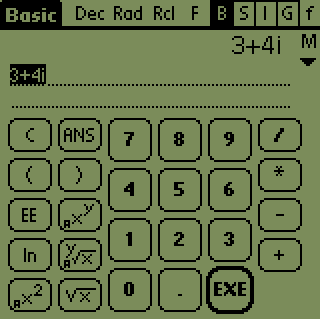
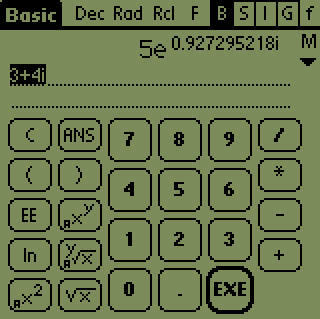
You can define your own functions that accept more then 1 parameter. You have to call the second parameter as x(2) third as x(3) etc. E.g. f()="x(1)+x(2)".

This is a basic implementation of financial calculator. You work with 6
different variables:
IT - interest pr. year. Note: from the 1.01 version this should be a
per-cent number, e.g. 12% interest should be written as i=12 and not as
i=0.12, like in earlier versions.
NP - number of payment-periods
PV - present value
PMT - payment (annuity) every period
FV - future value
P/YR - payments per year
and the Begin/End buttons, that affect when is the payment done - in the
beginning of the year or at the end (usually at the end).
Now you can try defining 5 variables and by tapping on the name of the 6th
it gets computed. Let's try an example:
By tapping on the buttons 'Undefined' near names of corresponding variables
you can enter values for every variable. Now most of those
'Undefined' messages should have disappeared. If you tap on the name of the
variable you wanted to compute, a notice 'Please wait' will appear in the
middle of the screen
indicating, that the calculator is computing, and you'll be able to
read the result as soon as the sign disappears.
Let's begin with drawing a simple graph. Go to graph preferences
(tap 'G' and then the letter 'P' or 'menu->Graph->preferences') and set it
exactly as you can see it on the screen-shot.
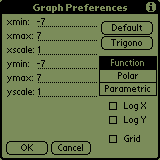
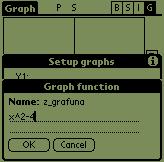
Now exit the preferences and go to setup (tap 'S' or 'menu->Graph->Setup
funcs'). Tap the blank space on the right of 'Y1' and enter "x^2-4". Exit setup
and look at the graph. If you see the graph to be drawing too fast,
you can make it faster by tapping the 'Sp' button and choosing the speed.
For the higher speed you get lower quality though.
If you want to delete a function or graph an already existing one, tap on
the function identifier (Y1,r1...) and a popup menu appears. Select 'None'
to hide a function, 'User' to create a special function for this graph (the
same one, as when you tap to the right of the identifier) or choose an
already existing function.

What can you do with the graph screen? If you tap on the graph and move the
pen, the
graph moves too. After you lift the pen, the graph is redrawn. The '-' button
is for 'zoom out' and the '+' button is for 'zoom in' (press the '+' button
and draw a rectangle, where do you want the new screen to be).
If you want to read the graph values, go to Menu->graph->table mode, and what you read are values of the parameter (x) and values of f(x).

You may want to trace a function like in the older version of EasyCalc. Tap
the 'T' on the right, select a function and tap on the screen. This works
perfectly for normal functions, but works somewhat worse for Polar and
doesn't work at all for Parametric functions. That's why you can use up/down
arrows and/or the 'Go' button to draw a cross directly on some value. You
may also start typing the value directly by graffiti and the 'GoTo' window
appears automatically.

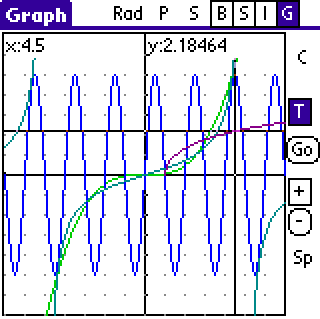
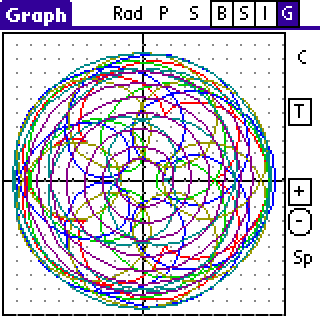 Parametric 'Art' ?
Parametric 'Art' ?
EasyCalc can do some numerical mathematics, it can compute root, minimum and maximum of a function, first and second derivation and integral. Tap the 'C' button on on the right side of screen and follow instructions. Result of the computation will be stored in a variable called 'graphres'.
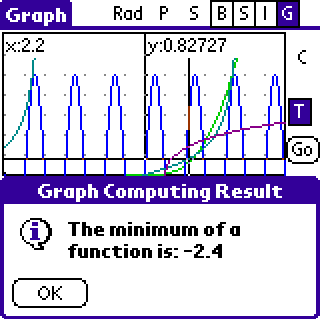 Selected 'C' and minimum then set left and right
boundaries ...
Selected 'C' and minimum then set left and right
boundaries ...
Lists can be thought as an extension of computation engine of EasyCalc. Most normal operation accept lists and produce a list as a result. E.g. sin(list(0:pi/2:pi)) = list(0:1:0). Of course you can freely add, subtract, multiply lists. The variation of a list can be easily defined as: sum(x-sum(x)/ldim(x))/ldim(x) (and it will work with complex numbers).
Lists work with these functions:
EasyCalc was written by Ondrej Palkovsky, ondrap@penguin.cz. Latest information is available on http://easycalc.sourceforge.net. I send many thanks to people who reported bugs and sent me language corrections to this tutorial. This product is still changing and if you feel that you encountered a bug (including an error in this tutorial, english is not my first tongue) feel free to contact me.